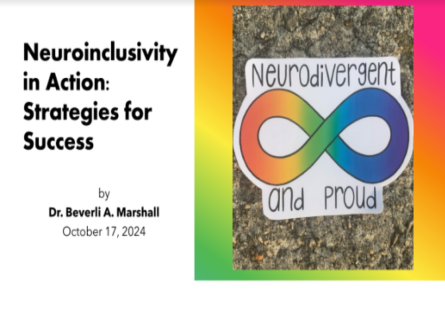
On Thursday, Oct. 17, Rio Salado College hosted a virtual event called Neuroinclusivity in Action: Strategies for Success. At Rio Salado College, we’re committed to supporting our diverse staff and student body, as well as promoting mental health and wellness (check out our blog on World Mental Health Day to see some of our wellness stories). This event braided those two objectives together, as our special guest sharedabout the importance of respecting and understanding neural diversity.
Reina Ferrufino, Chief Program Officer of Diversity, Equity, Inclusion, & Belonging at Rio Salado College, kicked off this event by introducing guest speaker Dr. Beverli Marshall. Marshall is the vice president of Administrative Services at South Mountain Community College. In addition to her educational work, Marshall has served as a city manager for Glenwood Springs in Colorado and Vallejo in California. She’s worked several managerial and oversight roles in positions related to housing, parks, sanitation, and public libraries. Her experience working with people from many different backgrounds is extensive.
Marshall’s academic background is in sociology, public administration, and neuroinclusivity. Marshall presented a slideshow on the topic of neuroinclusivity, unpacking this concept and explaining why she was so drawn to it. She began her presentation by talking about how there is “a lot of intersectionality between this and other forms of diversity.”
Quoting Neurodiversity Collaborator Wendy Graves, Marshall said, “imagine a bunch of oranges met an orange, but instead of just saying it’s an orange, they called it an Apple Deficiency Syndrome fruit.” Part of coming to terms with the concept of neural diversity is accepting that there isn’t a default- an ‘all minds are apples’ mentality- and that how there is a broad spectrum of how people perceive the world, process information, and experience and project emotion.
Marshall explained neurodiversity in simple terms.
“It’s neurological variances,” she said. “It’s wired into us. It is not changeable, it’s just who we are. Like eye color, hair color, skin color, how tall you are. Those are hardwired into us.”
She likened the struggles of people who are neurodiverse with a classic image: “It feels like being a square peg being shoved into a round hole. It’s not conforming, accepting, and supporting.”
Neurodiversity covers a range of variances that include autism spectrum disorder, attention deficit hyperactivity disorder, and learning sensory processing disorders (which includes dyslexia, dysgraphia, dyspraxia, and dyscalculia). Marshall emphasized that the use of “disorder” in these terms is purely a medical model and not a judgment or statement of “wrongness” about these neural states.
“Disorder implies broken, needs to be fixed,” Marshall said. “I’m only using this word because that is how they are defined in the DSM-5.”
The DSM-5 stands for the Diagnostic and Statistical Manual of Mental Disorders, a taxonomic and diagnostic tool used by mental health professionals. What is and isn't a "mental disorder" has shifted dramatically from one DSM edition to the next. Behaviors and identities that are now commonly accepted as healthy and normal (like homosexuality) were once considered diagnosable conditions in older DSM manuals.
Marshall went on to discuss each of the neurodiverse variances while also taking time to puncture myths and misconceptions people have about neurodiverse people.
“They aren’t all looking to be ‘fixed,’” she said.
Not all of them require medication either, or view their condition as an impediment. How people feel about their neural states and their degree of comfort with them can vary wildly from person to person, so one shouldn’t make assumptions about the kind of accommodations they need.
Differences can also prove to be advantageous.
“They have strengths: artistic, musical, mechanical talents,” Marshall said about some neurodivergent individuals. “They visualize the world differently because of the way they take in information and the way they process communication. …You could probably put all of these disorders in a room and you might have the perfect combination of talents because each of them has different strengths. Isn’t that true of any team? That’s the definition of inclusivity.”
A big part of neuroinclusivity, Marshall explained, was taking into consideration the kind of things that can discomfort and distract neurodiverse individuals. Sudden schedule/syllabus changes, overly chaotic and busy environments, unclear expectations, and even too much artificial light in a room versus natural lighting are just a few of the things that can overwhelm a neurodiverse person. Marshall stressed the importance of being proactive and finding out what people need to feel comfortable, to create environments where people feel comfortable advocating for their own needs.
“Not everyone feels comfortable or heard,” Marshall said, who also pointed out that some people feel uneasy about ”outing themselves” as neurodivergent. “Stereotypes and biases, they’re out there and they are strong. This is one of the last places where a lack of inclusivity actually has some social approval. The differently abled is the last place where people can still make jokes and exclude people and somehow it’s still okay.”
Winding down her presentation, Marshall took a few questions from the audience, offering advice to both students and instructors on how to make schools more inclusive for neurodiverse people. While she underlined the importance of schools and workplaces offering robust resources to help people thrive in those environments, for Marshall it’s maintaining a spirit of compassion and service that’s critical to making all people feel welcome.
“The solution is to ask, ask ask,” she said. “How can we do this better? How can I communicate? What kind of modality works for you? What location works for you? The environment, the lights, the temperature… there’s a wide variety of what people want or need.”
Watch Dr. Marshall’s Presentation
Article by Austin Brietta